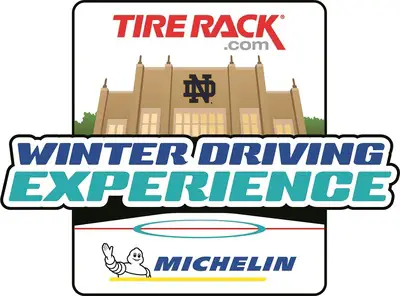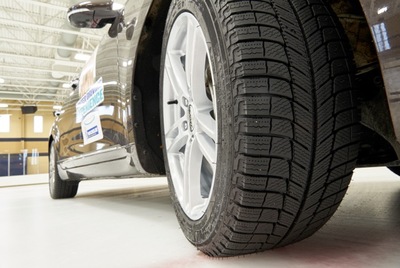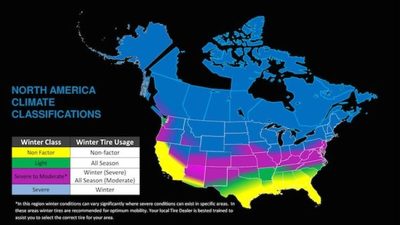Winter Tires ARE Worth It! - The Correct Tires Really Do Matter +VIDEO
 |
Winter Tires are Worth It: the Right Tires Matter
By Larry Nutson
Senior Editor and Bureau Chief
Chicago Bureau
The Auto Channel
Most every new vehicle today is equipped with all-season tires. This includes cars, minivans, SUVs and pickups. Many performance vehicles are equipped with summer tires or these summer/performance tires may be an option on certain cars and SUVs.
You make think, inferred by their name, that all-season tires are designed to handle any type of weather. Well, they are not. All-season tires are the “jack of all trades and master of none.”
So you say, “I know that but I drive a vehicle with all-wheel drive.” Many think all-wheel drive is the automotive antidote for handling winter roads.
The general thinking when driving in snow is to not get struck; to keep going. Well it’s also necessary to stop and to steer. All-wheel drive doesn’t help too much then.
If you’ve ever lost traction on a slippery winter road, then you know that performance and safety begin where your vehicle touches the ground, your tires.
On a hot late-summer day I was invited to join Michelin and Tire Rack for a cool experience. Instead of being outdoors in the 90º heat I would spend the day at a cool 50º inside the Compton Family Ice Arena on the University of Notre Dame Campus. On center ice we would be behind-the-wheel of matching vehicles experiencing the different traction behavior of all-season and winter tires.
In one exercise we drove identical front-wheel drive Kia Cadenza sedans, one equipped with Michelin X-Ice Xi3 winter tires and one with Michelin all-season tires. We accelerated from stop on the ice across a “theoretical” sixty-foot intersection. Our measured times clearly demonstrated the better traction of a winter tire, with the all-season tire Cadenza taking about 50 percent longer to drive the 60 feet.
In a second exercise we drove identical all-wheel drive Kia Sportage SUVs, one equipped with Michelin Latitude X-Ice Xi2 winter tires and one with Michelin all-season tires. This time we accelerated to a mark and then braked to a stop. We compared speed and braking distance. Not only did the winter tire Sportage accelerate to a higher speed but it needed less distance to stop relative to its speed.
All this was interesting, informative, very educational and also a bit of fun. Some of the benefits of winter tires I knew. However, the most compelling comparison for me of winter and all-season tires was a turning demonstration with the two all-wheel drive Kia Sportage SUVs. Our hosts didn’t want us slamming the boards, so Michelin’s pro-drivers took the wheel. In a low-speed 10-mph turn the all-season tire Sportage couldn’t hold the line and, basically, slid off our imaginary road.
Let’s cut to the chase. Why winter tires? Or, why not all-season tires? All-Season tires are designed to provide balanced dry, wet, and light/moderate snow traction performance levels for year round usage. Winter tires are specially designed for optimized traction on snow, slush and ice in addition to wet and dry roads in severe cold weather environment. That is, when temperatures are consistently below freezing and/or there is substantial winter precipitation. But note that, winter tires are not recommended for year round usage.
In ambient temperatures below 44ºF, all-season tires start to loose their flexibility and grip. Below 32ºF stopping distances increase even on dry roads. Summer/performance tires become so stiff below 32ºF they offer little traction.
Winter tires have tread pattern designs and technologies for snow and ice using cross sipes designed to grip the pavement and block edges that provide traction. Winter tires have tread compounds designed for low temperatures, snow and ice. Stopping distances on dry roads in temperatures below 20ºF are shorter with winter tires. .
This North American Climate Classification map show the areas of the U.S. and Canada (the blue) where winter tires should be fitted to all four wheels of your vehicle.
All-season tires are actually 3-season tires if you live in any of the areas in blue.
All-season tires are marked with the RMA symbol M+S. Winter tires are marked with the RMA symbol 3PMSF (3 Peak Mountain Snowflake) in addition to M+S indicating suitable usage for severe winter conditions.
There are some regulatory requirements for winter tires. Some western states require 3PMSF marked tires to pass through mountains, such as Colorado, Washington, Oregon, and British Columbia. And Quebec, Canada mandates 3PMSF marking during winter months.
Now we know there is a cost and convenience issue here to consider. Do two sets of seasonal tires save or cost more money?
The norm is you will need to replace the tires on your vehicle at around 60,000 miles, or about in the fourth year of ownership. Winter tires should be used for a portion of the year---from Thanksgiving to Tax Time. With the original all-season tires not being used for a portion of the year, you will stretch that tire replacement time out to around six or seven years.
There’s other savings in using winter tires. That’s the added safety for you, your spouse and your family; reducing the risk of injury; the expense of crash damages to your vehicle; paying the insurance deductible; higher insurance rates; the inconvenience; the time lost.
Winter tires mounted on an extra set of wheels can be easily stored in your garage or perhaps, if need be, at your local car dealer. It may sound inconvenient, but it’s worth it.
Personally, I’ve fitted winter tires to my wife’s car. We ended up using them on three different cars of the same brand and model-line that she leased---an investment that paid off for nine years.
I got my winter tires from Tire Rack. They’re very helpful. Take a look at www.tirerack.com.
Lastly, never forget the pressure. The air inside your tires supports the weight of your car. For every 10 ̊ F drop in temperature, tires lose about one pound per square inch (psi) of air pressure. A tire filled to 32 psi at 70 ̊ F will have only 28 psi at 30 ̊ F. Underinflated tires offer less traction, can reduce fuel mileage, can wear out prematurely and cause irreparable damage that compromises their durability. Check tire pressures monthly and add air to vehicle manufacturer specifications.
Something to think about!
This report comes from an invitation-only event that allowed special access to the vehicles and executives. Michelin and Tire Rack provided my overnight accommodations and meals.
© 2017 Larry Nutson, the Chicago Car Guy







